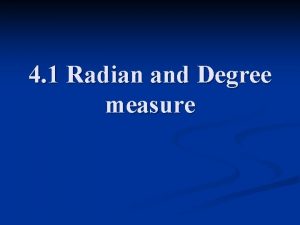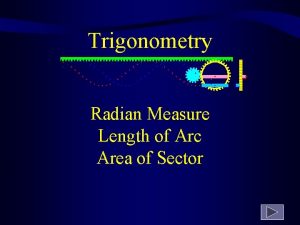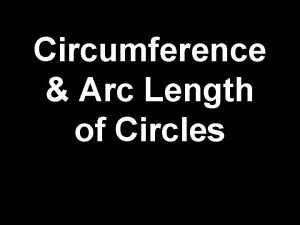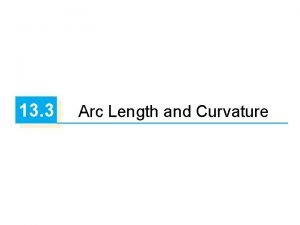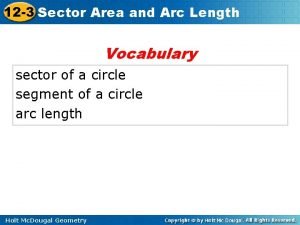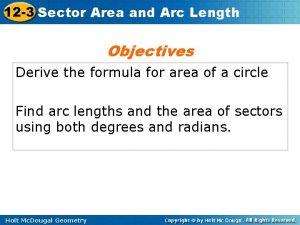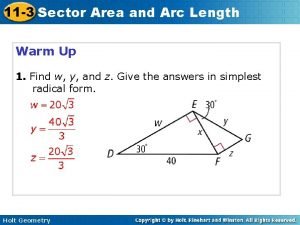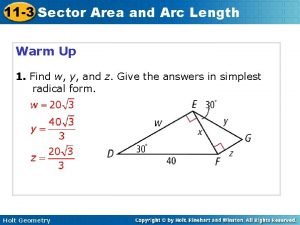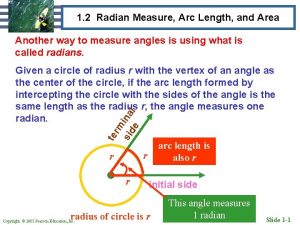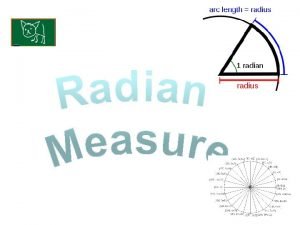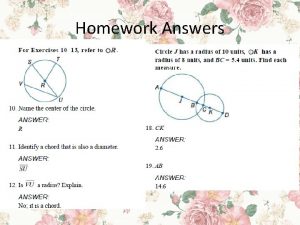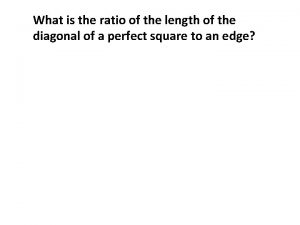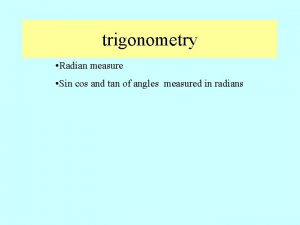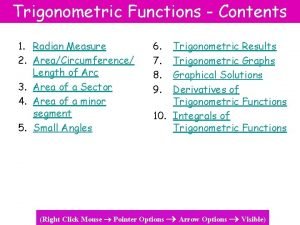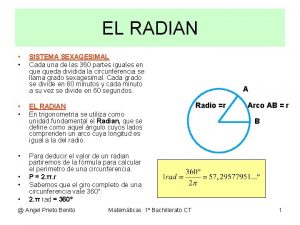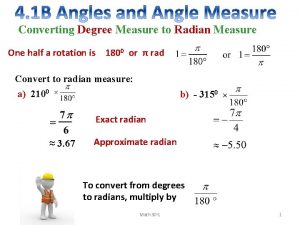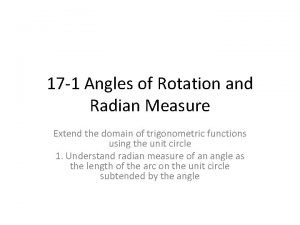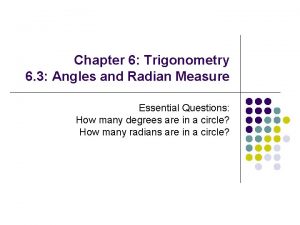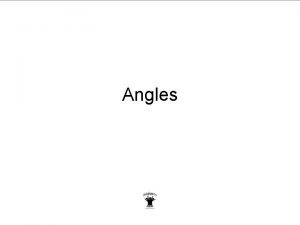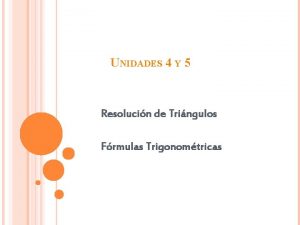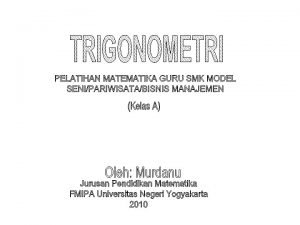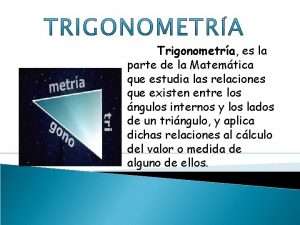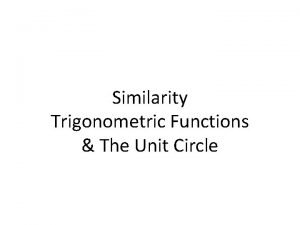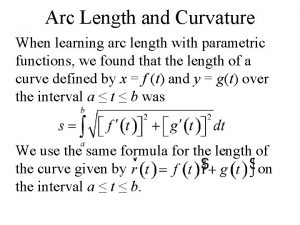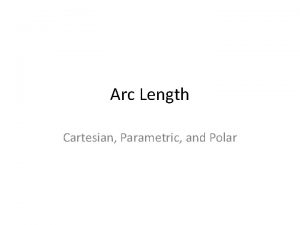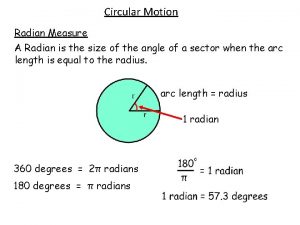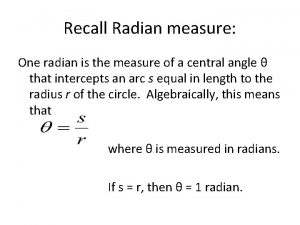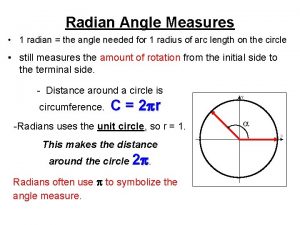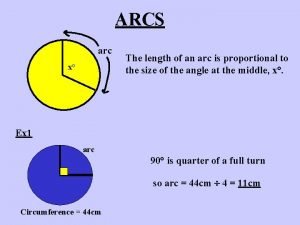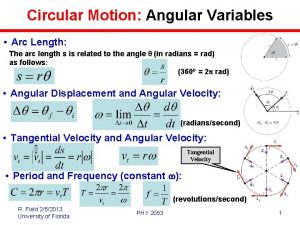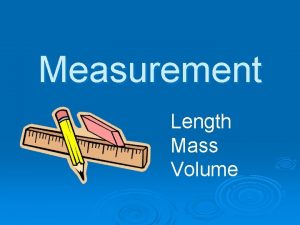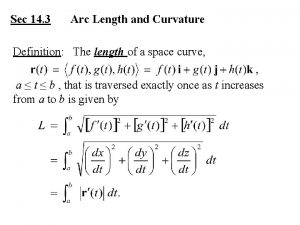Definition y Radian The length of the arc

































































- Slides: 65

Definition y Radian: The length of the arc above the angle divided by the radius of the circle. , in radians x

Definition y Unit Circle: the circle with radius of 1 unit If r=1, =s , 1 in radians x

Definition The radian measure of an angle is the distance traveled around the unit circle. Since circumference of a circle is 2 r and r=1, the distance around the unit circle is 2

Important Idea If a circle contains 360° or 2 radians, how many radians are in 180° • rads Use to change rads to degrees rads Use to change • 180° degrees to rads

Try This Change 240° to radian measure in terms of .

Try This Change radians to degree measure. 157. 5°

Try This Change radians to degree measure. 171. 89°

Definition Terminal Side y Vertex A Initial Side x Angle A is in standard position

Definition y A x If the terminal side moves counterclockwise, angle A is positive

Definition y A x If the terminal side moves counterclockwise, angle A is positive

Definition y A x If the terminal side moves counterclockwise, angle A is positive

Definition y A x If the terminal side moves clockwise, angle A is negative

Definition y A x If the terminal side moves clockwise, angle A is negative

Definition y A x If the terminal side moves clockwise, angle A is negative

Definition y A x If the terminal side moves clockwise, angle A is negative

Definition y A If the terminal side is on x an axis, angle A is a quadrantel angle

Definition y A If the terminal side is on x an axis, angle A is a quadrantel angle

Definition y A If the terminal side is on x an axis, angle A is a quadrantel angle

Definition y A If the terminal side is on x an axis, angle A is a quadrantel angle

Definition The quadrantal angles in radians

Definition The quadrantal angles in radians

Definition The quadrantal angles in radians

Definition The quadrantal angles in radians The terminal side is on an axis.

Definition Coterminal Angles: Angles that have the same terminal side. Important Idea In precal, angles can be larger than 360° or 2 radians.

Important Idea To find coterminal angles, simply add or subtract either 360° or 2 radians to the given angle or any angle that is already coterminal to the given angle.

Analysis 30° and 390° have the same terminal side, therefore, the angles are coterminal y 30° x y 390° x

Analysis 30° and 750° have the same terminal side, therefore, the angles are coterminal y 30° x y 750° x

Analysis 30° and 1110° have the same terminal side, therefore, the angles are coterminal y 30° x y 1110° x

Analysis 30° and -330° have the same terminal side, therefore, the angles are coterminal y 30° x y -330° x

Try This Find 3 angles coterminal with 60° 420°, 780° and -300°

Try This Find two positive angle and one negative angle coterminal with radians. , and

Important Idea r > 0 opp hyp adj hyp opp adj

Try This Find sin, cos & tan of the angle whose terminal side passes through the point (5, -12)

Solution 5 13 (5, -12) -12

Important Idea Trig ratios may be positive or negative

Find the exact value of the sin, cos and tan of the given angle in standard position. Do not use a calculator.

Solution 2 -1

Definition Reference Angle: the acute angle between the terminal side of an angle and the x axis. (Note: x axis; not y axis). Reference angles are always positive.

Important Idea How you find the reference angle depends on which quadrant contains the given angle. The ability to quickly and accurately find a reference angle is going to be important in future lessons.

Example Find the reference angle if the given angle is 20°. y In quad. 1, the given 20° angle & the x ref. angle are the same.

Example Find the reference angle if the given angle is 120°. For given y angles in quad. 120° 2, the ref. ? x angle is 180° less the given angle.

Example Find the reference angle if the given angle is. y x For given angles in quad. 3, the ref. angle is the given angle less

Try This Find the reference angle if the given angle is For given angles in quad. 4, the ref. angle is less the given angle.

Important Idea The trig ratio of a given angle is the same as the trig ratio of its reference angle except, possibly, for the sign. Example:

The unit circle is a circle with radius of 1. We use the unit circle to find trig functions of quadrantal angles. Definition 1

Definition The unit circle (-1, 0) x y (0, 1) 1 (0, -1) (1, 0)

Definition For the quadrantal angles: (-1, 0) (0, 1) The x values are (0, -1) the terminal sides for the cos function. (1, 0)

Definition For the quadrantal angles: (-1, 0) (0, 1) The y values are (0, -1) the terminal sides for the sin function. (1, 0)

Definition For the quadrantal angles : (-1, 0) (0, 1) The tan function (0, -1) is the y divided by the x (1, 0)

Example Find the (0, 1) values of (1, 0) (-1, 0) the 6 trig functions of (0, -1) the quadrantal angle in standard position: 0°

(0, 1) Find the Example values of the 6 trig (-1, 0) (1, 0) functions of the (0, -1) quadrantal angle in standard position: 90°

(0, 1) Find the Example values of the 6 trig (-1, 0) (1, 0) functions of the (0, -1) quadrantal angle in standard position: 180°

(0, 1) Find the Example values of the 6 trig (-1, 0) (1, 0) functions of the (0, -1) quadrantal angle in standard position: 270°

(0, 1) Find the Try This values of the 6 trig (-1, 0) (1, 0) functions of the (0, -1) quadrantal angle in standard position: 360°

A trigonometric identity is a statement of equality between two expressions. It means one expression can be used in place of the other. A list of the basic identities can be found on p. 317 of your text.

Reciprocal Identities:

Quotient Identities:

r y but… therefore x

Pythagorean Identities: Divide by to get:

Pythagorean Identities: Divide by to get:

Try This Use the Identities to simplify the given expression: 1

Try This Use the Identities to simplify the given expression:

Prove that this is an identity

Now prove that this is an identity

One More
 Smaw voltage
Smaw voltage Arc promoteur vs arc investigateur
Arc promoteur vs arc investigateur Minor arc and major arc
Minor arc and major arc Major arc geometry
Major arc geometry Arc emu88 com arc info 47 100047 html
Arc emu88 com arc info 47 100047 html 1 radian to degree
1 radian to degree Minor arc length
Minor arc length How to find length of arc
How to find length of arc What is a sector in geometry
What is a sector in geometry Arc length corollary
Arc length corollary How to find arc length
How to find arc length Arc lengh formula
Arc lengh formula Arc length and sector area module 16
Arc length and sector area module 16 Length of arc calculator
Length of arc calculator Arc length worksheet
Arc length worksheet Arc length worksheet
Arc length worksheet Arc length formula calculus
Arc length formula calculus Arc length corollary
Arc length corollary Arc length equation
Arc length equation 12-3 sector area and arc length answer key
12-3 sector area and arc length answer key 12-3 sector area and arc length
12-3 sector area and arc length Arc length versus sector area
Arc length versus sector area Circumference and arc length assignment
Circumference and arc length assignment 11-3 practice b sector area and arc length
11-3 practice b sector area and arc length 12-3 sector area and arc length
12-3 sector area and arc length Arc length of polar curve
Arc length of polar curve Arc length formula radians
Arc length formula radians Sector perimeter
Sector perimeter Sectors and segments
Sectors and segments 10-2 measuring angles and arcs answers
10-2 measuring angles and arcs answers Arc length
Arc length What is the ratio of the length of to the length of ?
What is the ratio of the length of to the length of ? Radian measure
Radian measure Radian area
Radian area Contoh soal radian ke sentisimal
Contoh soal radian ke sentisimal Rad trigonometria
Rad trigonometria Whats a radian
Whats a radian Angles of rotation and radian measure
Angles of rotation and radian measure Pengukuran sudut trigonometri
Pengukuran sudut trigonometri Unit of angular acceleration
Unit of angular acceleration 6-1 angles and radian measure answers
6-1 angles and radian measure answers Radiation pattern lobes
Radiation pattern lobes Vertex arm
Vertex arm Formulas mcu
Formulas mcu Pengertian satuan sudut
Pengertian satuan sudut đổi radian sang độ trong excel
đổi radian sang độ trong excel Medidas de los triangulos
Medidas de los triangulos Que es un radian
Que es un radian Rumus sudut lancip
Rumus sudut lancip Formula radian
Formula radian Radian circle
Radian circle El periodo de un disco con mcu es de 4 segundos
El periodo de un disco con mcu es de 4 segundos Mcu
Mcu Radian research, inc.
Radian research, inc. Shielded metal arc welding definition
Shielded metal arc welding definition Fcaw definition
Fcaw definition Welding chapter 10 review answers
Welding chapter 10 review answers Shielded metal arc welding definition
Shielded metal arc welding definition Arm's length bodies
Arm's length bodies Line of control length
Line of control length Hình ảnh bộ gõ cơ thể búng tay
Hình ảnh bộ gõ cơ thể búng tay Frameset trong html5
Frameset trong html5 Bổ thể
Bổ thể Tỉ lệ cơ thể trẻ em
Tỉ lệ cơ thể trẻ em Voi kéo gỗ như thế nào
Voi kéo gỗ như thế nào Chụp tư thế worms-breton
Chụp tư thế worms-breton





